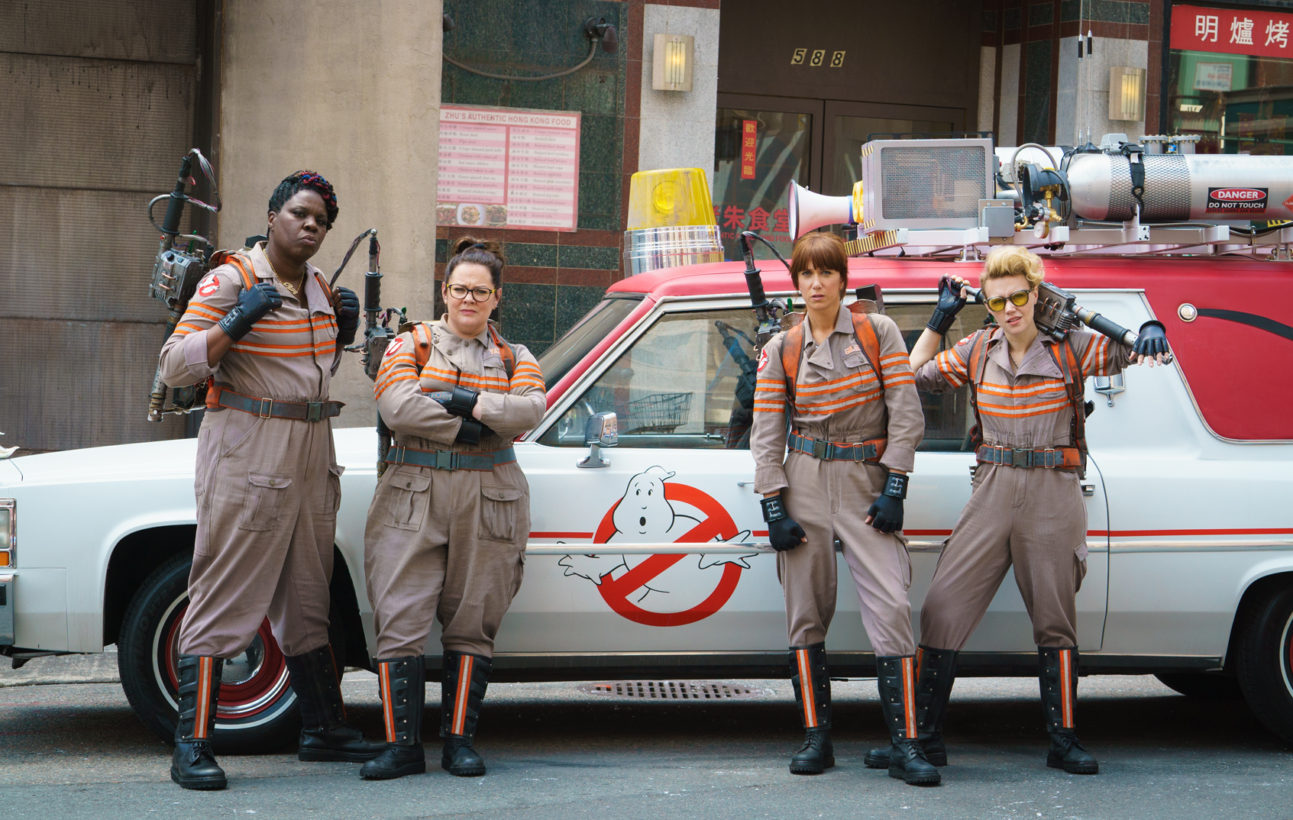
Ghosts of Our Past: gaze busting & the power of reboots
It seems like Hollywood can’t get enough of reboots. They lurk everywhere, in every genre, recycling the same story over and over again. Sure, it’s easy to repackage an old hit and sell it back to the audience, but does it really do anything for cinema overall? Are we so postmodern that we have moved even beyond trying to convince ourselves that there are any new stories to be told? Or even that there was more than one story in the first place? If it must come to pass that remakes and adaptations must rule the box office, then let them do something to make the same story fresh and stir society up some. Perhaps the world has resigned itself to a finite number of stories, but let’s hope it never thinks there are finite ways of telling them.
The latest in the never ending slew of “take-two’s,” Ghostbusters (Paul Feig 2016), is a perfect example of a worthwhile remake. Successfully wielding its reboot status to simultaneously strike the nostalgia chord and shake up the status quo, the film stars a familiar quartet of science-savvy spirit snaggers, only this time Kate McKinnon, Leslie Jones, Kristen Wiig, and Melissa McCarthy take to the screen in a gender swapped cast. Unfortunately, some took the announcement of all female leads for the Hollywood favorite better than others. Shortly after its release in March 2016, the film’s trailer became the most disliked movie trailer on YouTube. Controversy sprung up all across the internet as fandom purists pushed back against the casting decisions. Flash forward to current box office figures, and though the movie raked in a fair $46 million its opening weekend, it was left trailing The Secret Life of Pets (Yarrow Cheney, Chris Renaud 2016), which totaled $50.6 million. This puts it just below the industry standard of $50 million for a successful opening figure.
Ghostbusters represents more than an attempt to revive a franchise though. By placing women in the formerly male-only hero roles, the film allows a new exploration of girls getting to kick butt, make jokes, and both reverse and divert the gaze. More interestingly, and perhaps importantly, however, is how going to see the movie has transcended the screen to evolve into a sort of political act in support of female leads and in opposition to the initial and ongoing backlash the film has received for choosing to cast women in its main roles.
One of the film’s great successes is how Ghostbusters subverts the male gaze so prominent in its predecessor. In the 1984 film, Bill Murray’s Peter Venkman started out as a serial womanizer with an only barely bearable side of sleaze. Once captivated by Sigourney Weaver’s Dana Barrett, he pursues her relentlessly, eventually getting the girl after saving both her and the city at the end of the film. The 2016 film’s women are not objects of pleasure, but entities in their own right, capturing monsters, fighting evil, and generally being a force to be reckoned with. Even beyond letting them be powerful though, this reboot lets its women simply be human. Clad in actually practical jumpsuits and rubber boots, they make jokes, test new devices, and get to be unapologetically weird. They even take the opportunity to turn the gaze back around on Kevin, the hunky secretary portrayed by Chris Hemsworth, who the team hires essentially solely for his looks. And, when Kevin is taken over by the spirit of the villain, not only does his possessor remark on the physique of his “upgrade”, the Ghostbusters are given the opportunity to reverse the typical role of damsels in distress and fight to return Kevin to his normal self. The new Ghostbusters are just here to save the day and be themselves.
Beyond the actual content of the movie, the revolution has spread to viewers as they are starting to let their money speak for them in support of the feature. Going to watch and support in cinemas has become something of a political act following the continual controversy the film has faced over its female leads. “When a big-budget movie starring men does poorly, it’s just another dud that’s shrugged off. When one made by or starring women doesn’t live up to the hype, it becomes a referendum on women as artists and filmgoers,” writes Andi Zeisler in her Los Angeles Times article “Why feminists have an obligation to see ‘Ghostbusters’.” If a significant reboot starring prominent leading ladies flops, then it is easy for Hollywood to assume that it’s just not what people want to see. Audiences have begun to realize this and spread the call to go see the film in theatres to tell studios that is far from the case.
So, while the sad truth might be that reboots may mainly exist to rehash stories and rake in cash, they can still become a valuable platform for interesting cinematic dialogue. By placing themselves at the intersection of past and present, memory and progress, reboots are able to provide a home for and launch important conversation about the progression of views over time and the influence of the cinema in society. Any more remakes should definitely look to take a proton out of Ghostbusters’ pack and inject some new perspective into their old tales in order to help keep film moving into the future.
Comments are closed, but trackbacks and pingbacks are open.